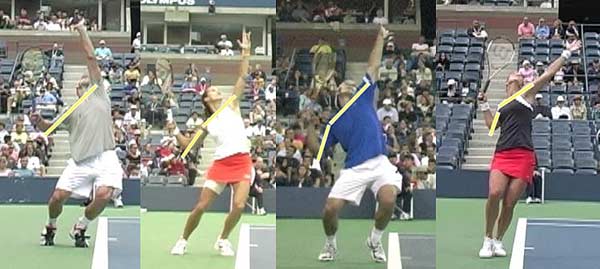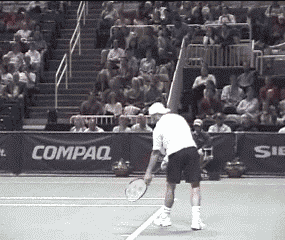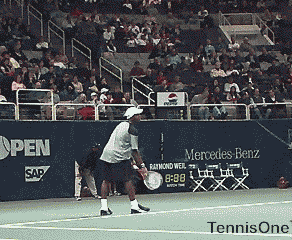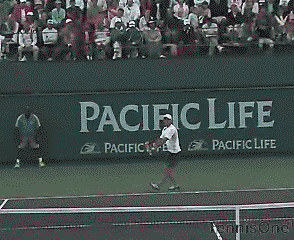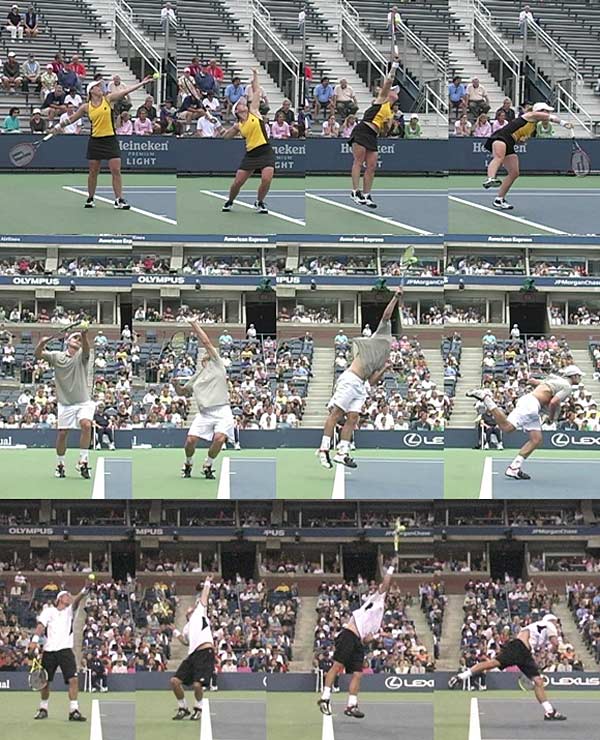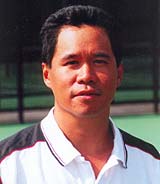|
TennisOne Lessons Rhythm and the Toss of the Serve Doug Eng EdD, PhD We often hear about how important the toss is for the service motion. Many teaching pros emphasize the toss and have their students practice it. In addition, much has been written about the ideal toss height. Some notable pros have long endorsed a low toss, that is, toss only to the contact point. The argument for the low toss is that when the ball reaches its peak, it is easiest to hit since it is nearly stationary (especially if windy). Others suggest you should toss about 18-24” above the contact point. The argument for the higher toss has been that as the ball accelerates down, it is easier to apply topspin and there is more time to load the legs and shoulders for power. Before I go further, it is important to realize that we are addressing what some coaches consider as styles of strokes, rather than fundamental or essential elements. The backswing and timing are highly individualistic styles. It might be debated that the style of service motion is not important for the effectiveness of the serve. The Release The release can be a bit difficult to measure since it is a matter of definition and visual clarity. Let’s define the release as when the ball comes off the fingers. Most touring pros in this study released the ball 0” to 4” above the top of the head.
There is some variance in the release. The lowest release in this study was by James Blake who released the ball 4” below the top of his head. The highest release point was Marat Safin who released the ball 9 to 10” above the top of his head. In Photo 1, we see Safin (left) and Blake side to side. Both players release the ball from the fingertips. Because Safin releases the ball highest, his toss and time from release to contact might be the shortest. In addition to the release and the rhythm of the service motion, other factors might affect the height of the toss. One of these factors is the ability of the player to extend up to contact point. Some players get off the ground significantly and others barely get off the ground. The player who gets highest off the ground might reduce the time between release and contact point. The Racquet Arm-Down Backswing At the release, there are three general types of racquet arm positions. Some pros let the racquet drop down as the ball is released. In Photo 2, we see Mardy Fish, Lleyton Hewitt, Novak Djokovic and Elena Dementieva are examples of the racquet arm-down backswing. The elbow of the racquet arm remains close to the body and the racquet is held down. Fish is shown with the racquet at 5 o’clock, Hewitt drops the racquet head at 6 o’clock, and Djokovic and Dementieva hold the racquet at 7 o’clock. Dementieva has already turned her racquet away from the net. All except Djokovic are evenly balanced as the racquet’s position does not aid weight transfer to the back foot yet. Djokovic is slightly more extended than the others, and hence, the weight shift to the back foot. Beginners may have problems with the long rhythm of the down backswing which is hard to time.
The Classic Backswing The second service motion is the classic backswing or the away backswing. In this motion, the racquet drops into a pendulum downswing and moves back as the tossing arm goes up. The elbow separates from the body and often the racquet is turned away from the net or towards the back of the court. This motion tends to be the most continuous of the three types of backswings. I differentiate this motion from the down motion primarily due to the elbow position which may simplify timing. In Photo 3, we see Andre Agassi, Roger Federer, Mark Philippoussis, and Donald Young using this motion.
Young is, of course, a lefty but I reversed his image so he appears right-handed for comparison. All shifted their weight back during the initial backswing phase. Agassi, Federer, and Philippoussis all hold the racquet essentially at the 8 o’clock position. Young is at the 9 o’clock position or parallel to the ground. Agassi and Federer both have their palms down and the racquet hitting side is still downwards. Philippoussis and Young have their palm in a sideward position so the racquet hitting face opens towards us. Assuming there is no hitch or pause in the backswing, we might suspect that Young might need the least time or perhaps the lowest toss. The Abbreviated Backswing The third class of backswings is when both arms go up immediately. Andy Roddick is most famous for what many call an abbreviated backswing. Within this class, there are variations of the up backswing. Photo 4 shows Robby Ginepri, Justine Henin, Andy Roddick, and Rafael Nadal. Ginepri holds the racquet at 3 o’clock and Henin is at 1 o’clock. Roddick and Nadal hold the elbow at shoulder height with the racquet close to parallel to the ground. Nadal has his weight on the front foot. Interestingly, Nadal never develops a foot-rocking position.
Assuming there is no hitch or pause in the backswing, the lowest toss could occur in the up backswing. That is, Henin, Roddick and Nadal might have potentially the lowest toss since their racquets travel the shortest distance. We might guess that the down backswing motion in Photo 2 might require the highest toss since the racquet path will be the longest. Rhythm, Gender and the Power Position I looked at 20 male and 13 female pros who are classified in Table 1 according to their backswing. It is worth noting that 10 (=50%) of the male pros used the classic away backswing. Only 4 (=20%) used the down backswing. That means, the majority of males separated their elbow from the body as the ball was released. The females, in contrast, predominantly used the down backswing which means the elbow remained close to the body.
The release is an important checkpoint you can use to determine your style. Sequentially, the next key checkpoint is the power position which is defined as after the toss when the racquet is pointed upwards as the knees are loaded and flexed before firing upwards. A number of coaches have observed that in the power position (Photo 5), most young children and female club players have lower elbows than male club players. This difference might be due to less shoulder stability in club-level females and children. BYU-Hawaii coach, Dave Porter, has also noted that in the two-handed backhand, females tend to take the arms and elbows closer to the body than males. Among touring pros, this elbow difference in the serve may not be significant. One must be careful how to define the low elbow since when the tossing arm is high, the elbow of the racquet arm is naturally down. The frame of reference is the angle between the shoulder line to the elbow. In Photo 5, we see four variations. First, Roddick’s elbow and shoulders are in a straight line. Amelie Mauresmo comes close to a straight line whereas Richard Gasquet has a slight drop. Lindsay Davenport’s angle is most significant among these four. It is important to realize that the elbow in this position may be lower than the shoulder line but never higher.
Rhythm and Footwork There are some important links between rhythm and footwork. Consider that there are two general types of footwork on the serve: the pinpoint and the platform stance. In Photo 5, Davenport (far right) uses a pinpoint and Gasquet (in blue shirt) uses a platform stance. There are other variations such as dragging (e.g., Sampras), narrow platform (e.g., Roddick in Photo 5), and wide pinpoint. The pinpoint is where the back foot moves forward along the ground to meet the front foot before the racquet swings up to contact. The platform is where the back foot doesn’t move until after the power position when it may come directly up and off the ground.
The pinpoint stance appears to develop most often with the down backswing. Of all backswings, the down backswing tends to keep the weight transfer to the back foot which creates a natural foot-rocking position. It is natural to then slide the back foot forward to the pinpoint stance. Players using the up backswing might inhibit initial weight transfer. Because both arms go up, there is no natural weight on the back foot. In Photo 4, we see Nadal’s weight slightly forward. Nevertheless, Roddick and Henin did shift their weight back. For the club player, it is worth seeing whether it occurs naturally. Weight transfer, however, fully occurs in the power position (see Gasquet in Photo 5). If the narrow platform is linked to any backswing, it tends to be the up backswing (e.g., Roddick, Nadal, Gasquet, Mauresmo). Last, 9 out of 13 players using the away backswing used the platform stance. Timing and the Toss Height It has been argued that the ideal toss is a) 18 - 24” above the contact point or b) to the contact point. It is reasonable to hypothesize that as the down backswing requires the longest racquet path, it would consistently require the highest toss. In addition, perhaps the up backswing or a classic away swing with the racquet arm almost parallel to the ground (at 9 o’clock) might take the shortest time and path. Curiously, the player in this study with the shortest time between release and contact point is Donald Young. He released the ball 5-6" above his head. His racquet got to a 9 o'clock position in the classic away backswing. In the video below, his toss was 0-1" above the contact point (the lowest in the study, although he also tossed 8" above the contact point on another serve, showing individual variation) and he got off the ground 9" high. It took Young only 0.62 seconds from release to contact point. And he currently serves around 130 mph. Aside from the possibility of Young, none of the players in this study tossed the ball only to contact point.
On the other hand, Gaston Gaudio released the ball when his racquet was at 5 o’clock, still in the down position. To reduce the time of his swing, he actually shortens his motion that takes the racquet from down to straight up. Also, he compensates by tossing about 5.5 feet above his contact point. It took Gaudio 1.24 seconds to go from the release to contact, exactly twice as long as Donald Young. Interestingly, the women in this study typically took longer from release to contact than the men. The range of the women’s times was also fairly narrow from 0.85 to 1.17 seconds. None of the women in this study tossed the ball 18” or less, although there are some low-tossing females (e.g., Conchita Martinez). In comparison, the male pros ranged from 0.62 to 1.24 seconds. Among low-tossing men (under 12”) are Young, Nadal, Davydenko and Dent. In contrast, Federer, Safin, Philippoussis, and Djokovic all toss 30” or more. It is difficult to say whether the toss is linked to big serves as sometimes suggested. The most striking gender difference occurred with the style of backswing and timing. The time from release to contact for male pros was consistently 0.15 seconds less than for the females for the same backswing style. Table 2 shows this difference. The up motion was also generally the fastest motion averaging about 0.05 seconds less.
Naturally, as a function of time, female pros also tended to toss higher than the males. The argument that the ideal toss is to the contact point is not practically supported here. Only the male pros using the up backswing or an away backswing to near 9 o’clock tossed under 12” above the contact point including Davydenko, Nadal, and Young. The second theory of 18-24” above contact point was also unsupported here. Safin, Philippoussis, Federer, and Djokovic are all effective servers and toss a minimum of 30”. Players with other styles tossed 23 to 32 inches above the contact point. In fact, it is very difficult to toss the ball 12-18” unless using either the up backswing or the away backswing at 9 o’clock with the racquet arm. Could the gender difference between toss height and time be due to racquet head speed? Typically male touring pros serve 110-130 mph whereas female pros typically serve 90-115 mph. Female pros may not only hit the serve with 15% less velocity but also typically require 15% more time to execute the backswing. Research shows that females generally have 2/3 the strength of males particularly in the upper body. However, when corrected for height and weight, similar power production should be expected. The fact that the women in this study are on the average shorter and lighter than the men, they are expected to produce slightly less power. Rhythm, Contact Point and Landing into the Court Since it appears that the rhythm of the backswing and the toss are related, one might ask if the rest of the serve is affected. For example, one might ask whether the contact point orthe ability to land into the court is affected. Table 3 shows the average contact point broken down with backswing type. In Table 3, we see that the farthest reach into the court was often achieved by the male and female pros using the down backswing. Often the down backswing coupled with the pinpoint stance promotes greater loading to the back foot, weight transfer, and apparently reach. The away and up backswing produced shorter reaches which may be more dependent on the stance.
For comparison, we might examine whether the stance alone makes a difference. The bottom of Table 3 shows the effect of stance on the contact point. It is not clear if the stance alone makes a difference. One could also argue that some backswing styles lend themselves to different types of tosses.
After the contact point, players often land far into the court on the left foot (right-handed player). Table 4 shows the average distance of the landing into the court. The height above the ground does not appear related with the type of backswing. However, the stride landing distance into the court seems closely related to the contact point in Table 3. For example, the farthest reach (26.5”) and stride (30.3”) was achieved by the male group using the down backswing. The females who used the away backswing reached least into the court (13.0”) and landed only 11.0” into the court. Again, stance alone may not be a significant factor in promoting a farther landing into the court. For comparison, Photo 6 compares key positions in the serves of Lisa Raymond, Andy Roddick and Lleyton Hewitt. Raymond uses an away backswing, Roddick an up backswing and Hewitt uses a down backswing. In the power position, we can see Raymond uses a platform stance, Roddick a narrow platform stance, and Hewitt a pinpoint stance. Hewitt makes contact and lands the farthest into the court which is generally true for most people using his service style. Raymond, even if she is of smaller stature, reaches and lands the least into the court. Males who use the away backswings and platform stances (e.g., Baghdatis, Federer) tend to not reach or land as far into the court.
Pace and Styles Rhythm style, toss height, reach, and other attributes may not be significant factors in influencing racquet head speed. For example, Marat Safin and Andy Roddick have very different backswing styles but both have big serves. Davenport and Henin have very different rhythms and stances but produce big serves. So should you be trying to reach far into the court on contact or land far into the court? Probably not. It depends on your style of serve. Fernando Gonzalez and Marcos Baghdatis typically make contact with the ball only six inches in front of the baseline and neither takes a big stride into the court, yet they can produce 130 mph serves. Henin reaches and lands far into the court and her serve is relatively big for her size. Lleyton Hewitt has great reach and stride into the court but doesn’t have the same power as Andy Roddick or Sam Querrey who have only a modest reach and landing into the court. One might attribute that to size and leverage. It is reasonable to say that certain rhythms and stances add to power but other contributing factors were unaccounted. Two important factors in developing power are internal rotation of the shoulder and wrist flexion. That makes it difficult to suggest which serve results in the most power. If there is a minimum requirement, perhaps you can make contact close to a foot into the court where you can accelerate the racquet head. You probably should land at least six inches into the court which demonstrates you had sufficient shoulder and arm acceleration and weight transfer. Conclusions There is the old adage, “you are what you eat.” Here, we have seen that the backswing rhythm and toss affect subsequent techniques in the service motion. Biomechanists define the kinetic chain as the sequence of movement of adjacent body parts. For example, the sequence:
must occur in proper timing and order to maximize power. Toss a tiny pebble into a pond and you can see a ripple effect. Your body in motion is similar to that ripple effect. We have seen that there are favored techniques that separate male and female pros. In this study, most female pros prefer the down backswing which likely leads to the pinpoint stance. Men prefer the away backswing (and second, the up backswing) which is linked to the platform stance. As to answering the question about toss height; unless you are using an up backswing or achieve the racquet arm position near 9 o'clock when releasing the ball, you should toss a minimum of 18" above the contact point. Typically, that gives about 0.8 – 0.9 seconds to finish the backswing. A higher toss of 24 – 32" works better with the down backswing which typically requires about 1.0 second to swing. A minority of touring pros do serve effectively with tosses higher than 32". If you are tossing low, around 12", the up backswing can be reasonably completed in about 0.7 – 0.8 seconds. Although there are outlying individuals, I would not necessarily copy extremes. For example, Donald Young's serve or Gaston Gaudio's serve may be hard to duplicate in timing. Or, releasing the ball as high as Marat Safin may be difficult for club players. Keep in mind that there are many variations which allow you to find your own rhythm. Even with an individual pro, the timing, toss, and rhythm do vary slightly from serve to serve. Don't feel your toss needs to be always perfect. Although technique was affected, we didn’t see much evidence for power being related to the style of motion. We can discuss the backswing, feet, and contact point as much as we want but recent research has shown that the most important sources of power are the internal rotation of the shoulder and wrist flexion. Neither movement is accounted for in this article. A last suggestion is for you to use this information to develop your own style of serving knowing you have quite a few good choices. Your comments are welcome. Let us know what you think about Doug Eng's article by emailing us here at TennisOne.
Doug Eng EdD PhD coaches men's tennis at Tufts University. During the summer, he directs at the Tennis Camps at Harvard. He has received divisional Pro of the Year honors from the PTR and USPTA and several national award. Doug completed the USTA High Performance Coaches program and frequently runs educational and training programs for coaches. Doug also writes and speaks on tennis and sport science. |
|||||||||||||||||||||||||||||||||||||||||||||||||||||||||||||||||||||||||||||||||||||||||||||||||||||||||||||||||||||||||||||||||||||||||||||||||||||||

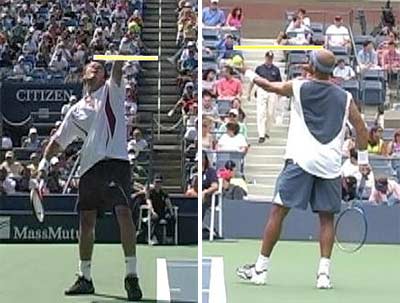
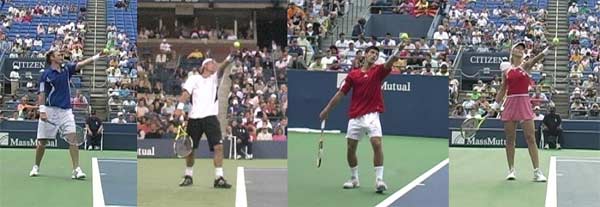 Photo 2: Mardy Fish, Lleyton Hewitt, Novak Djokovic, and Elena Dementieva.
Photo 2: Mardy Fish, Lleyton Hewitt, Novak Djokovic, and Elena Dementieva.

